
Last Updated: June 14th 2025
What Is Tagger by Sprout Social?
Tagger Media (currently known as Tagger by Sprout Social) is an influencer marketing and social intelligence platform that helps brands go beyond basic influencer search. It combines influencer discovery with powerful social listening and analytics tools, allowing brands to track trends, analyze conversations, and build more strategic influencer campaigns.
Before getting to explore Tagger media review, let’s take a quick look at its history:
- Founded in 2015 as a music recommendation engine.
- It is located in Santa Monica, California.
- The founder is Peter Kennedy.
- Transitioned from a music recommendation engine to an influencer marketing platform.
- Acquired by Sprout Social in August 2023 for $140M; rebranded as Tagger by Sprout Social.
- The platform claims to have 6M influencers.
Currently, Tagger Media has been fully integrated with Sprout Social’s platform. It means, there is no separate website or platform. No matter if you search for Tagger Media or Sprout Social, both direct you to the same website, which is Sprout Social.
So, from now on, we are going to review Sprout Social.
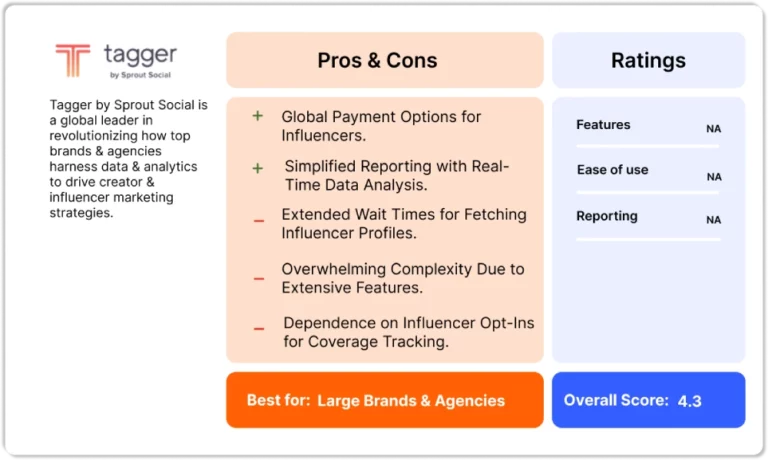
Tagger Review (Sprout Social Review): Pricing, Features, Pros & Cons + Best Alternative
In this Tagger Media review, we’re taking a close look at Sprout Social features to explore how it operates against other options.
While some platforms provide large databases and detailed analytics, others focus more on connecting users or integrating with e-commerce.
We will check out all the features that Tagger and Sprout Social have collected in one place. Then, we will help you find Sprout Social alternative that does everything this platform does with many free tools.
Check out Ainfluencer. It’s a free influencer marketing platform with a database of 5 million influencers.
So, let’s see what Tagger by Sprout Social offers to its customers.
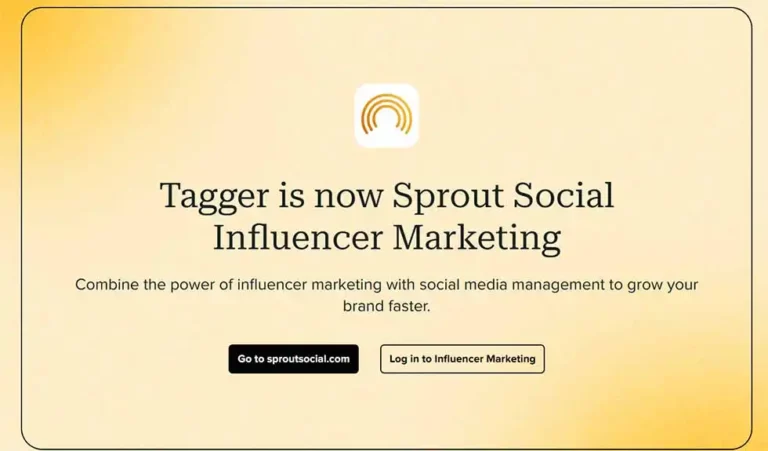
Tagger by Sprout Social Features: What the Platform Has to Offer
Tagger by Sprout Social now offers different tools for influencer marketing and social listening, which we are going to explore one by one.
Now, let’s dive into its features!
1. Creator Discovery
Like most influencer marketing platforms, Tagger by Sprout Social also provides tools to search for influencers across various platforms, including Instagram, TikTok, and YouTube.
While an exact current number for the entire Sprout Social influencer database is not explicitly stated, it is clear from Tagger’s description that the platform includes millions of influencer profiles worldwide (reported to be 10M).
Meanwhile, using the AI-powered tool, the platform allows brands to find creators based on different filters. Additionally, to make it easier to find the right influencer, they can see creators’ past participations and analyze their performance.
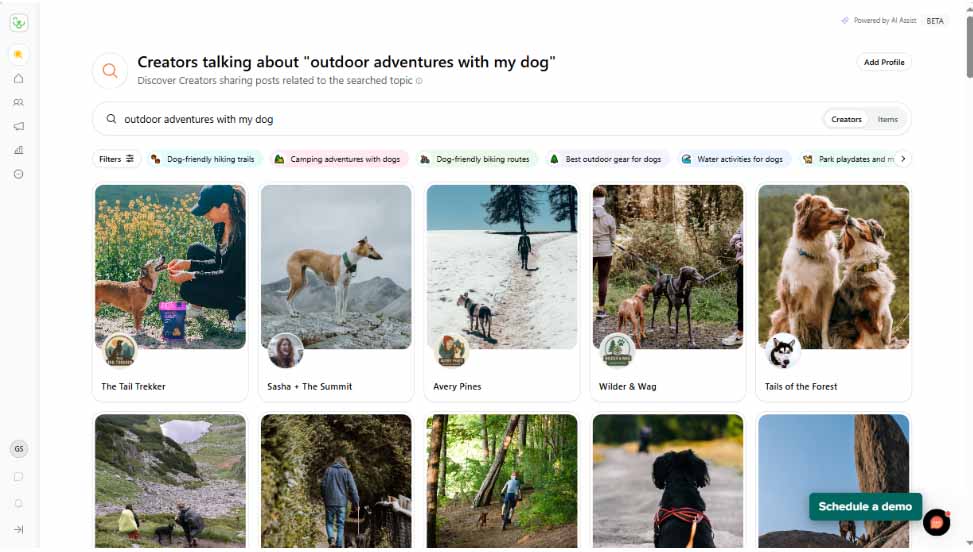
Sprout Social now lets you identify the right creators by topic – its AI-powered, topic-led search surfaces brand-aligned influencers faster than ever.
How to Find Influencers on Tagger by Sprout Social?
To find the right creators on Sprout Social, you must take the following steps:
- Open the Discover or Creator Suggestions section.
- Use filters to narrow influencers by topics, audience, and performance.
- Check each influencer’s content and past collaborations to see if they fit your brand.
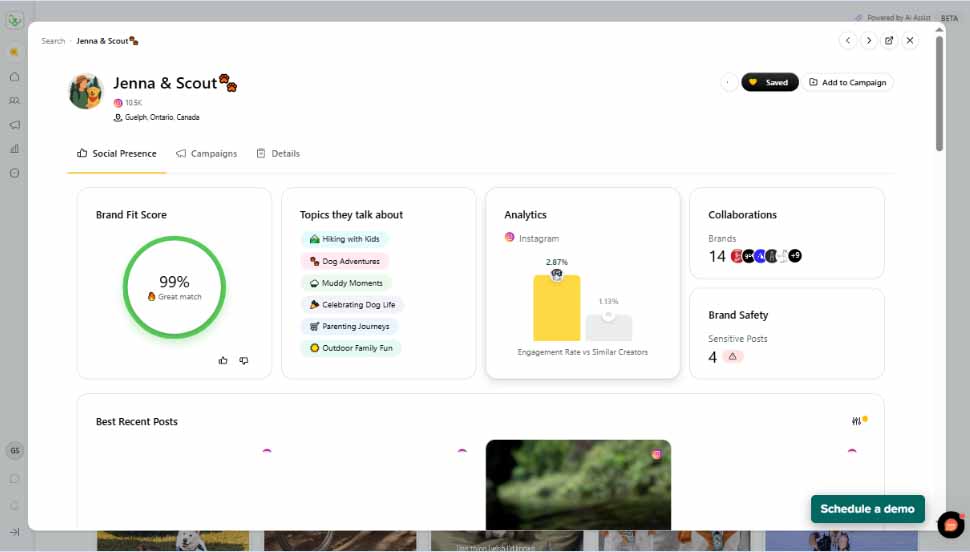
4. Review the Brand Safety Report to avoid risky creators.
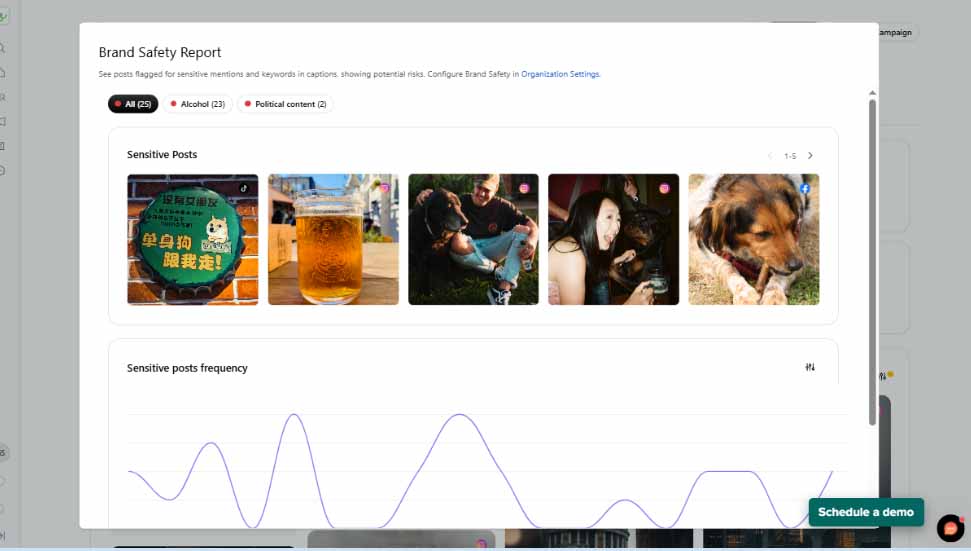
5. Look at their audience demographics and how they compare to similar influencers.
6. Add the influencers you like to a Creator List to organize them.
7. Use the Creator Suggestions feature to find more influencers like the ones you picked.
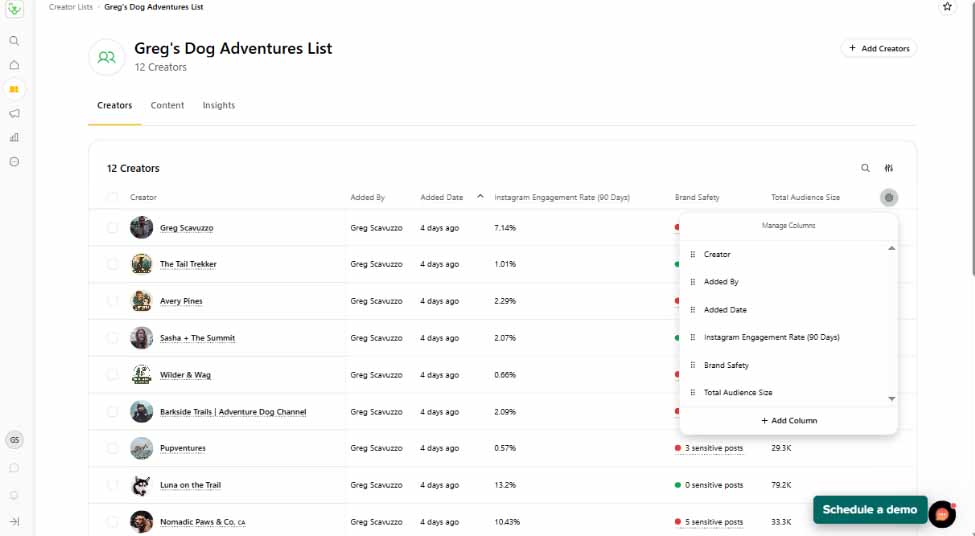
2. Campaign Management
Tagger by Sprout Social Campaign Management lets you run your influencer campaigns from start to finish in one place.
First, you can organize influencers using Creator Lists. This is where you group creators, compare their performance, and keep track of useful details like clothing sizes or birthdays.
Before moving forward, you can check Brand Safety reports, which help you see if a creator’s content aligns with your brand and avoid risky topics. You can also use Creator Suggestions to find similar influencers and speed up your discovery process.
When you’re ready to start the campaign, you manage everything in Creator View. You can send outreach messages, handle contracts, create discount codes, and manage all other activation steps here.
The Dashboard helps you stay on track with outreach, budget pacing, content pipeline, and hiring progress in your Campaign Dashboard to stay aligned with campaign KPIs.
Although all these features might sound interesting to advertisers, they can be Tagger’s drawback too because it can be overwhelming for users who are trying to learn how to utilize the entire product.
If you want to test a simpler platform, you can always count on Ainfluencer. Creating an influencer marketing campaign and finding an influencer will only take a few clicks. You don’t need to take much time learning how to work with this platform. Everything is out there in a simple, user-friendly platform.
3. Analyze and Measure
Campaign Analysis in Tagger by Sprout Social helps you measure results and track industry trends. You can create reports from scratch or use ready-made templates.
For example, the Competitive Analysis template lets you compare your brand’s performance with your competitors across seven different report tabs.
4. Social Listening and Intelligence
Want to make smarter marketing decisions? This unique creator listening and business intelligence tool helps marketers craft better strategies. It quickly processes complex queries and finds the most relevant content from a massive library of social posts, giving you the insights you need to make informed choices.
It helps users by providing features like:
- Trend Analysis: Helps users spot trends in the creator community and track keyword performance and audience insights to improve influencer and social media strategies.
- Competition Monitoring: allows users to keep an eye on their competition, showing what’s working for them and what’s not, giving you an edge in the market.
You might think we’ve covered everything, but there’s still more to explore! Let’s take a look at some of the other great features. Tagger also offers:
- Communication & Collaboration: Easily manage influencer requests with a public portal and pre-qualifying questions, plus tools for smooth teamwork and better campaign management.
- Data Analysis & Visualization: Track over 9 billion social conversations for insights, and easily visualize 300+ metrics like likes and comments to make smart decisions.
- Integration & Compatibility: Collect data from all major social media platforms in one place with API integration for a complete view of your social activity.
You may also consider what its costs are. Let’s jump right into it!
Tagger by Sprout Social Pricing
Checking the Sprout Social website, we can see different pricing plans for social media marketing. However, none of them include influencer marketing. So, if you want to use this platform for influencer discovery, campaign creation, or any related features, you should request a demo.
For some businesses that want to compare different platforms, it’s always the best option to have a free trial and public pricing. Although Sprout Social has a 30-day free trial, it just includes its social media marketing.
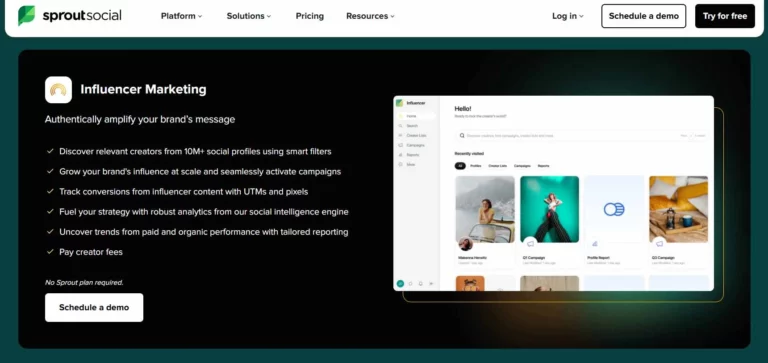
So, while Tagger media (Sprout Social influencer marketing tool) is a powerful tool, it may be too expensive for smaller brands, who may prefer a more affordable or transparent alternative.
Did you know influencer discovery, campaign creation, and direct communication with influencers are all free features on Ainfluencer? You don’t need to pay a penny to use all these features. Just join and start your influencer marketing campaign.
Influencer is definitely the best Tagger alternative you can use.
Tagger Reviews: What Do Its Customers Say?
Now it’s time to see what Tagger customers say about this platform. Are they completely satisfied, or have they found some drawbacks that made them not find this platform useful for their business?
Note: There is no Tagger platform right now; it has been integrated with Sprout Social. Therefore, all thesefeedbacks are for the times that Tagger Media was a separate platform. However, to understand how well Sprout Social’s influencer marketing is performing, we still need to examine Tagger reviews, since Sprout uses Tagger’s database.
Some users have reported encountering bugs within the Tagger platform. While these issues are not described as critical, they can still be frustrating and disrupt the user experience. It’s important to note that no software is entirely bug-free, but these bugs are worth considering.
Here’s a user’s feedback in this regard:

Moreover, the clients have expressed a desire for a more automated content tracking feature. Specifically, they wish for a functionality that would automatically track all mentions and coverage of a brand’s profile without relying on influencers to sign up.
There’s also another drawback that will make you switch to other similar tools.
Some users have reported that Tagger can be a bit slow when running on their laptops. This might result in delays or slower performance when using the platform.
Here’s a user’s comment that proves our claim:

As you can see, considering these limitations and bugs, Tagger is not the best option for most advertisers. Given these concerns, it’s worth exploring alternative platforms.
Ready?
What Are Tagger Pros and Cons
Looking to learn more about Tagger or Sprout Social influencer marketing? Here’s a quick look at the pros and cons of the platform to help you decide if it’s the right fit for your needs.
Pros
- Large influencer database
- Advanced social listening tools
- Detailed campaign analytics
- Influencer CRM and collaboration
- E-commerce and Shopify integration
- Global payments and legal support
Cons
- Lack of pricing transparency
- Steep learning curve
- Cluttered user interface
- Limited content tracking
- Missing Instagram Story data
- Occasional data inaccuracies
- No self-serve signup option
Ainfluncer: Best Tagger Alternative
Ainfluencer serves as a comprehensive influencer marketplace for brands seeking collaborations with influencers across diverse niches such as fashion, beauty, and music. That’s why it is considered one of the best Sprout Social influencer marketing alternatives.
Advertisers can easily join Ainfluencer for free, create as many campaigns as they like, and search for influencers on a list of +5M creators who are active on Instagram, YouTube, and TikTok.
The influencer discovery is done based on different filters, including gender, location, category, number of followers, hashtags, and your budget.
Now finding the right influencer is easier than before as you can access a list of influencers who are aligned with your preferences.
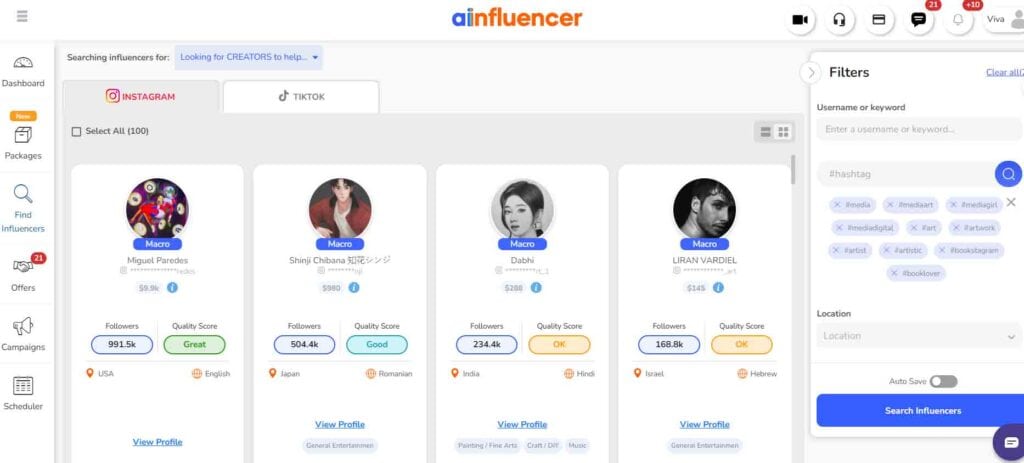
Furthermore, those who may doubt if an influencer will be effective for their business can check out reviews and ratings on each influencer to see if previous collaborations were successful. In the end, they can also leave their comments about each influencer to help other advertisers find the creator who brings more engagement.
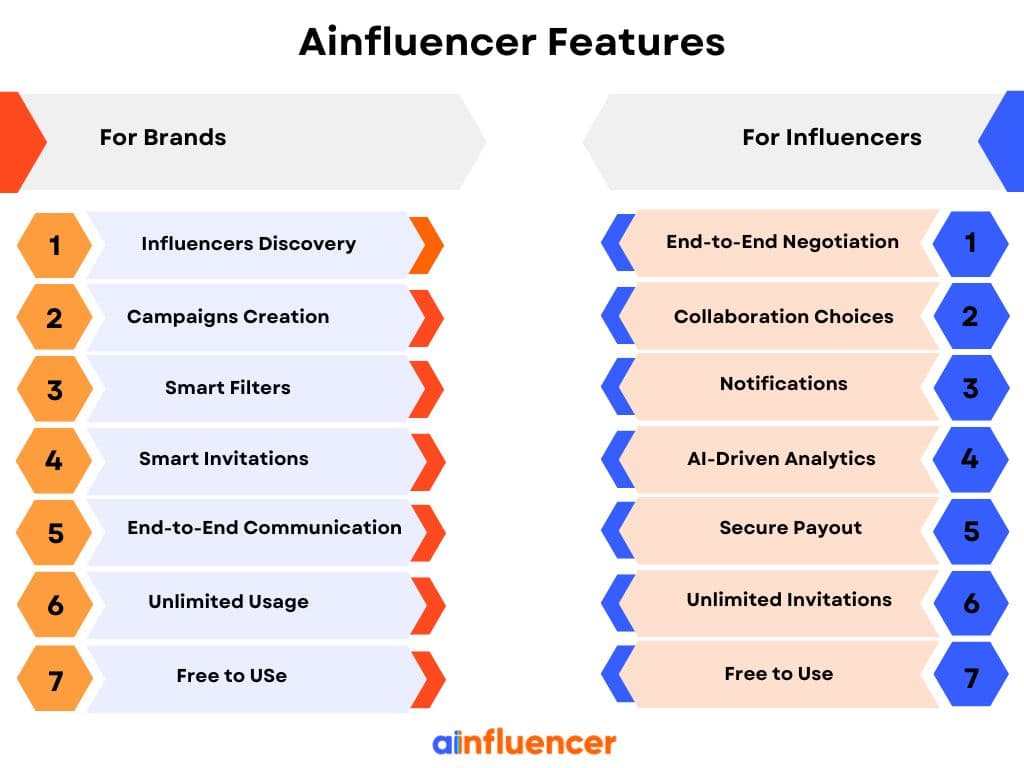
Ainfluencer’s Core Values
- Access to the Right Influencers: Ainfluencer has an extensive database of influencers which is easy to search.
- Grow Campaigns with Less Work: Brands can use automation tools to make their marketing easier. This helps them find influencers, manage deals, and track results more quickly and efficiently.
- In-depth Analytics: You can dive into influencers’ niches, audiences, and past experiences to make informed choices.
- 100% Free for Influencers: Ainfluencer is completely free to use. Influencers of any size—from nano to macro—can join and work with brands without paying any subscription fees or upfront costs.
- Effective Campaign Management: It helps you easily run successful campaigns with Ainfluencer’s intuitive tools.
- Connect with Global Brands: The platform helps influencers connect with over 100,000 brands from around the world, offering lots of chances to work on different projects and promote products.
- Limitless Walkthroughs: You’ll receive all the guidance you need to navigate the influencer marketing landscape.
- Secure and Convenient: It conducts unlimited offers, negotiations, and payments securely within the app.
- Smart Matching with AI: Ainfluencer uses smart technology to match brands with the best influencers. It looks at things like age, interests, and online behavior to create more effective and personalized campaigns.
- DIY Campaigns: Ainfluencer enables you to set your campaign preferences your way for maximum customization.
- Detailed Influencer Insights: Brands can see useful information about each influencer, like how good their content is, how much people engage with it, how many people they reach, and their earning potential.
- Boost Visibility: You’ll effortlessly increase brand awareness through influencer partnerships.
- Easy Collaboration Tools: The platform makes it easy for influencers and brands to talk, send proposals, and make deals directly in the app.
- Responsive Support: You can expect top-notch customer support whenever you require assistance.
- Great for Small Businesses: Ainfluencer is built to help small businesses. They can find micro-influencers and run campaigns without needing big budgets or long contracts.
- Shopify Integration: You can link your influencer campaigns with Shopify to track sales and ROI directly.
But the most common question people ask is: How does Ainfluencer make money if it’s 100% free for both brands and influencers?
The answer is simple—Ainfluencer takes a small commission from the payments brands make to influencers. Neither the brand nor the influencer pays any upfront fees, and the platform only earns a small portion of the money from each completed deal.
| Features | Tagger | Ainfluencer |
|---|---|---|
| Database of Influencers | 10M | +5M |
| Pricing Options | No Free Trial | Free |
| Influencer Search | Yes | Yes |
| Number of Invitations | Not Mentioned | Unlimited |
| Number of Campaigns | Not Mentioned | Unlimited |
| Campaign Management | Yes | Yes |
| Detailed Insights | Yes | Yes |
| Shopify Integration | No | Yes |
No matter your industry, Ainfluencer simplifies the process of finding and collaborating with the right influencers.
Join Ainfluencer today and set your brand on the path to marketing success!
Tagger Alternatives: Notable Platforms to Consider
Here are other Tagger competitors:
1. Upfluence
As an is an all-in-one platform, Upfluence helps brands run both influencer and affiliate marketing campaigns in one place. With Upfluence, brands can easily find top affiliates, set up commission plans, and track sales using built-in tracking tools. It supports different ways to share profits, which is great for brands that want flexible partnership options.
Tagger, on the other hand, focuses more on influencer marketing and social media insights. It helps brands discover the right creators, manage campaigns, and measure success with powerful data tools. Tagger is especially strong when it comes to tracking trends and improving campaign results.
The big difference? Upfluence includes affiliate marketing features, making it more handy for brands that want to use both influencer and affiliate strategies. It also makes hiring easier with smart AI tools and ready-to-use contract templates.
In short, both platforms are strong in their own way—Upfluence offers more all-around tools, while Tagger is perfect for deep influencer insights and smart campaign management.
2. Heepsy
Trying to decide between Heepsy and Tagger for your marketing campaigns? Heepsy is great for small businesses. It’s easy to use, budget-friendly and has a huge database of over 11 million influencers. It even offers a free plan and helps you spot real, engaging influencers on Instagram, YouTube, TikTok, and Twitch.
However, Tagger is built for bigger brands. It offers powerful tools like social listening, real-time data, and custom workflows. While pricing isn’t listed publicly, it’s packed with advanced features and integrates with Sprout Social, making it ideal for large-scale campaigns.
In conclusion, Heepsy is simple, affordable, and great for small businesses. Tagger is more advanced, with powerful tools for large, data-driven brands. Choose Heepsy for ease, or Tagger for depth.
3. IZEA
Tagger is a great choice for large brands that need advanced analytics, social listening tools, and custom workflows. It helps manage complex campaigns across different regions and provides deep insights, but its pricing isn’t publicly available, which can make it hard for smaller businesses to access.
IZEA, however, offers a vast network of over 4.3 million content creators across major platforms like Instagram, YouTube, TikTok, and Twitch. It’s more affordable and accessible, with clear pricing starting at $130/month and a free plan to test the platform. IZEA also offers AI-powered tools like FormAI for content creation and analytics, making it an appealing choice for smaller teams.
In summary, Tagger is best for big, complex campaigns with advanced needs while, IZEA is better for smaller businesses looking for an affordable, easy-to-use platform with a large creator network.
4. CreatorIQ
Next Sprout Social (formerly Tagger) alternative is an influencer marketing platform used by global brands for its powerful AI-driven discovery and advanced fraud detection. CreatorIQ integrates with multiple social platforms and CRM systems.
CreatorIQ provides better fraud prevention and more seamless integrations, reducing risk and increasing workflow efficiency compared to Tagger’s sometimes slow interface.
Read CreatorIQ review
5. Aspire (formerly AspireIQ)
Aspire focuses on building authentic influencer relationships with easy-to-use campaign management, influencer CRM, and automated payments. It supports influencer discovery across multiple platforms with strong e-commerce integrations.
This Sprout Social (formerly Tagger) alternative offers a simpler interface and direct influencer marketplace browsing, unlike Tagger’s lack of an influencer marketplace. Its strong Shopify integration helps brands directly track sales, improving ROI measurement.
Read Aspire review
Conclusion
While Tagger offers a range of valuable features, it’s important to consider Tagger media review, potential limitations and user feedback, including reports of occasional bugs and performance issues on certain devices.
For those seeking an alternative, Ainfluencer emerges as a robust solution, offering an all-in-one influencer marketplace for brands and influencers alike.
FAQs
Tagger is a multifaceted digital marketing research tool that offers a range of services. These services include influencer search and discovery, campaign management, an influencer marketplace, and third-party analytics.
Tagger’s capabilities extend beyond traditional influencer platforms, making it a robust solution for digital marketing research.
Sprout Social (formerly Tagger) does not publicly disclose its pricing plans on its website. To obtain detailed information about their pricing structure, you will need to contact Tagger directly.
Typically, Tagger operates as a Software as a Service (SaaS) company, which means users are required to pay a subscription fee for access to their services. It’s worth noting that Tagger primarily caters to larger businesses and may not be cost-effective for smaller enterprises.
As Tagger Media reviews show that it does not offer a free trial or a free version of its platform. However, you can request a demo to explore its features before committing to any plans.
Since Tagger’s pricing is not publicly available, the demo gives potential users a chance to understand how the platform works and decide if it meets their needs before making a purchase.
Tagger is a legitimate platform widely used by brands and influencers for influencer marketing, so yes it is totally regulated. It offers powerful tools for campaign management, social listening, and analytics. However, its hidden pricing and complex user interface can be drawbacks for some users, which is why some may prefer to explore alternatives that offer more transparency and simplicity.
No. At the moment, there is no free trial for using influencer search on Sprout Social influencer marketing (or Tagger media). You should schedule a demo to see how it works and how much it may cost.